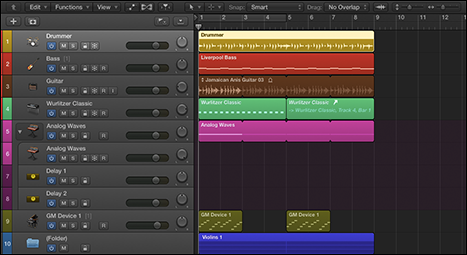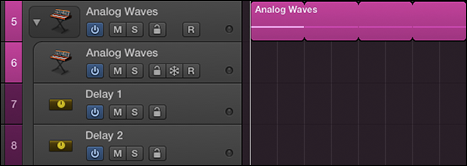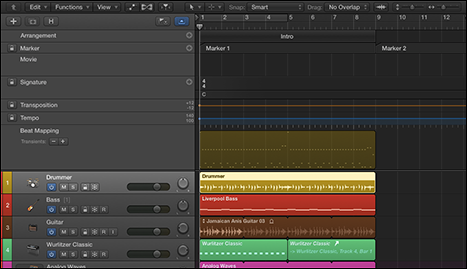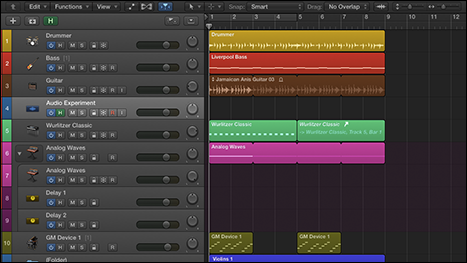Chapter 4
Embracing Tracks and Regions
In This Chapter
![]() Understanding how tracks and regions work
Understanding how tracks and regions work
![]() Adjusting your tempo and time signature
Adjusting your tempo and time signature
![]() Saving track settings for instant recall
Saving track settings for instant recall
![]() Editing and looping regions
Editing and looping regions
Tracks and regions are the basic building blocks of your project. You can have up to 255 audio tracks and 255 software instrument tracks in a project, so it’s safe to say that you won’t ever run out of tracks.
Each track gives you independent control over the sound and placement of a single sound source. These days, multitrack recording might not seem like such a big deal because your iPhone has similar capabilities, but it wasn’t that long ago when multitrack recording didn’t exist. Now we have nondestructive recording and editing with 200 steps of undo history. It’s tempting to say with a straight face that you can record better than The Beatles.
Regions are objects on your tracks that you create, edit, and manipulate until your ear is content. Regions are versatile containers for your creative ideas.
In this chapter, you find out about several track types and region types as well as gain some basic region editing skills.
Knowing Your Track Types
As described in Chapter 3, the tracks you create are added to the vertical track list to the left of the tracks area, as shown in Figure 4-1. You create more tracks by clicking the new tracks (plus sign) icon at the top of the track list or by choosing Tracks⇒New Tracks. You can also create specific track types with key commands and with the Tracks menu.
In this section, you discover what the different track types do and how to create them.

Figure 4-1: The track list.
Audio track
An audio track, like the one shown in Figure 4-2, can contain audio regions, audio Apple loops, and imported audio files. You use an audio track when you want to record a live instrument or a microphone, as described in Chapter 6. You can also import prerecorded audio files and loops into your project, as described in Chapter 8.

Figure 4-2: An audio track.
To create an audio track, do one of the following:
- Press Option-
 -A.
-A. - Choose Track⇒New Audio Track.
You can edit audio tracks by using the audio track editor or the audio file editor. For more on editing audio, see Chapter 14.
Software instrument track
A software instrument track, shown in Figure 4-3, can contain MIDI regions, MIDI Apple loops, and imported MIDI files. You use a software instrument track when you want to record one of Logic Pro’s software instruments or a third-party software instrument that you’ve installed.

Figure 4-3: A software instrument track.
To create a new software instrument track, do one of the following:
- Press Option-
 -S.
-S. - Choose Track⇒New Software Instrument Track.
You record MIDI data on software instrument tracks, which are covered in Chapter 6. You can edit software instrument tracks by using the piano roll editor, score editor, and step editor, which you will learn about in Chapter 15.
Drummer track
A drummer track is used when you want to add a virtual drummer to your project. The drummer track, shown in Figure 4-4, won’t let you play its drums (sounds like a lot of drummers I know); the only way to control a drummer track is in the dedicated drummer editor, which you’ll learn about in Chapter 9.

Figure 4-4: A drummer track.
To create a drummer track, choose Track⇒New Drummer Track. Logic Pro doesn't have a built-in key command for this option, so why not create one now? I chose Shift-Option-![]() -D for my key command. (For information on creating key commands, see Chapter 3.)
-D for my key command. (For information on creating key commands, see Chapter 3.)
You learn how to make beats with Drummer in Chapter 9. Drummer, which is new to Logic Pro X, plays and sounds amazing. Because Drummer was created using human drummers and recording engineers, it sounds natural. It can even respond to a track of your choosing. Artificial intelligence has arrived and it's got rhythm.
External MIDI track
An external MIDI track, shown in Figure 4-5, can contain MIDI regions. Use an external MIDI track when you need to send MIDI data to an external device such as a synthesizer or a drum machine. External MIDI tracks make no sound of their own, so you must send the MIDI data out to your MIDI device and receive the audio signal from your MIDI device on a separate audio track.

Figure 4-5: An external MIDI track.
To create a new external MIDI track, do one of the following:
- Press Option-
 -X.
-X. - Choose Track⇒New External MIDI Track.
In the tracks area, external MIDI tracks look and behave a lot like software instrument tracks, because they both contain MIDI data. But if you open the inspector (press I), you’ll see that the channel strip of an external MIDI track looks very different than a software instrument track. The external MIDI track has no audio capabilities and no plug-ins. A MIDI channel strip, covered in Chapter 16, is used to route MIDI data through a MIDI port on a MIDI channel. Using different MIDI ports and MIDI channels allows you to build a project that can communicate with many different external instruments, up to 16 channels per instrument.
Track stacks
Track stacks, an innovation in Logic Pro X, help you organize your tracks by placing them as subtracks within a main track. You expand and collapse the track stack by using the disclosure triangle, as shown in Figure 4-6.

Figure 4-6: A track stack.
Two types of track stacks are available:
- Folder stack: A folder stack can control the volume of all the tracks in the track stack. All the tracks can be automated, soloed, muted, and grouped as a whole. But folder stacks can’t be saved as patches and you can’t add effects to the entire group or control their audio output as a group.
- Summing stack: This stack routes audio, saves all tracks and their settings, and can be saved as a patch for later recall. All tracks in a summing stack send their audio outputs to a collective auxiliary track. You find out more about audio routing and auxiliary tracks in Chapter 16.
To create a track stack, follow these steps:
- Select the tracks you want to include in the track stack.
To select more than one track at a time, hold down the
 key while making your selections.
key while making your selections. - Press Shift-
 -D or choose Track⇒Create Track Stack.
-D or choose Track⇒Create Track Stack. - Select the type of track stack you want to create.
Your choices are Folder Stack or Summing Stack.
- Click Create.
The tracks are now grouped in a track stack.
You can remove the tracks from a track stack by selecting the track stack and choosing Track⇒Flatten Stack or pressing Shift-![]() -U.
-U.
As mentioned previously in this section, summing track stacks can be saved as a patch for instant recall. For example, you can build an entire orchestral project with dozens of software instrument tracks (as described in Chapter 12) and save the tracks as a patch. Your orchestral track stack is then available for all your projects. Like smart controls, track stacks deliver a more productive workflow.
To save a summing track stack as a patch, follow these steps:
- Select the summing track stack in the track list.
- Open the library by pressing Y or by choosing View⇒Show Library.
- Click the Save button at the bottom of the library and name your patch.
- Click Save.
Your patch is now saved in the library.
To load a patch on a selected track, simply select the patch in the library.
Folder track
A folder track is similar to a track stack, but folder tracks are focused more on regions. Track stacks organize tracks; folders organize regions. A folder track, shown in Figure 4-7, can contain multiple tracks and their regions but doesn’t have its own channel strip.

Figure 4-7: A folder track.
You might use a folder track to
- Store tracks you’re no longer using
- Organize the regions of song sections
- Organize arrangements and parts in a song
- Sequence longer material, such as albums and musicals
To create a folder track, do the following:
- Select the regions in the tracks area.
- In the tracks area toolbar, choose Functions⇒Folder⇒Pack Folder.
To view the contents of a folder track, double-click the folder. To exit the folder, click the leave folder arrow on the far left of the tracks area menu, as shown in Figure 4-8.

Figure 4-8: Folder track contents.
You can unpack a folder by selecting the folder and choosing Functions⇒Folder. Then choose Unpack Folder to New Tracks if you want to create tracks in the tracks area of the current project level, or choose Unpack Folder to Existing Tracks to use the existing tracks of the current project level.
As you just discovered, tracks do more than just hold audio and MIDI. They are creative instruments that you can play and explore.
Around the Global Tracks
Global tracks, shown in Figure 4-9, contain lanes and data, but they’re global to the project. Global settings such as tempo and time signature changes affect the entire project, and you set them in your global tracks.

Figure 4-9: The global tracks.
To display your global tracks, do one of the following:
- Choose Track⇒Global Tracks⇒Show Global Tracks.
- Press G.
- Click the global tracks icon at the top right of the track headers menu.
You might not see all available global tracks on the screen. To choose which global tracks are displayed, do the following:
- Choose Tracks⇒Global Tracks⇒Configure Global Tracks or press Option-G.
- Select the global tracks you want to show.
- Click Done.
Here’s a brief description of the different global tracks:
- Arrangement track: The arrangement track creates special markers that are meant to help you organize your project based on common song sections, such as chorus, verse, and intro.
- Marker track: The marker track lets you mark spots on your project. You can name your markers, put descriptive text on them, and navigate to them by using key commands.
- Movie track: The movie track shows thumbnails of imported movies. To import a movie into your project, choose File⇒Movie⇒Open Movie. You can choose to extract the audio from the movie into a track in your project.
- Signature track: The signature track controls both the key signature and the time signature of your project. You can change either at any point in your project by selecting the pencil tool on the tool menu and clicking where you want the change to occur.
- Transposition track: The transposition track transposes MIDI and Apple loops but not audio files. Click the track with the pencil tool to create a transposition node. Drag the node up or down and MIDI regions, MIDI Apple loops, and audio Apple loops will follow the transposition track.
- Tempo track: The tempo track defines your object tempo. Double-click anywhere in the tempo track lane to create a new tempo node. Adjust the tempo by dragging the node up or down.
- Beat mapping track: The beat mapping track aligns the project tempo to the content on your tracks. It’s useful for projects that don’t have a consistently perfect tempo.
Global tracks are covered in even more detail in Chapter 13, where you learn about arranging.
Sorting and Hiding Tracks
You can move tracks by dragging the track headers up and down. You can also sort tracks automatically according to type or whether or not they are being used by choosing Tracks⇒Sort Tracks By.
Hiding tracks is useful when you want to clean up your project. You might not be ready to delete a track that’s no longer being used, but you want it out of the way. Here’s how you can hide tracks:
- Click the green hide icon on the track header menu (or press H if the icon isn’t visible), as shown in Figure 4-10.
Hide icons will appear also on each track.
- Click the hide icon on the track you want to hide.
The icon turns green.
- Click the hide icon in the track header again.
The icon turns orange, indicating that tracks are hidden. The track is hidden from the track list and the channel strip disappears from the mixer.

Figure 4-10: Hiding tracks.
To unhide your tracks, click the hide icon in the track header. The tracks are again displayed in the track list and mixer.
Knowing the Region Types
The rounded rectangles in your tracks area are called regions. Think of regions as flexible placeholders for your audio and MIDI data. Regions can be empty, waiting for you to add content, or created as you record new content. Regions are references to your MIDI and audio data. They can even reference a reference, allowing you to change one region and have all other regions follow suit.
In this section, you discover the different types of regions and how to use them.
Audio region
An audio region can be your own audio recording, an audio Apple loop, or an imported audio file. Audio regions, shown in Figure 4-11, can be only audio tracks. You can identify an audio region by its audio waveforms.

Figure 4-11: An audio region.
Audio regions contain references to audio files. An audio region isn’t the file itself, and this is important to remember. If you split an audio region in half, for example, the audio file isn’t split in half. And if you delete a portion of an audio region, the audio file isn’t deleted — it simply isn’t referenced by the region any more. If you want to get that portion of audio back, all you have to do is drag the edge of the region. You learn more about basic region editing later in this chapter.
MIDI region
A MIDI region contains MIDI data. MIDI regions can be used on software instrument tracks or external MIDI tracks. You can identify MIDI regions by their thin rectangle note events, as shown in Figure 4-12.

Figure 4-12: A MIDI region.
MIDI regions are more flexible than audio. You can definitely manipulate audio beyond recognition, but you can’t remove a single note from an audio file and put it on its own track, as you can with MIDI. MIDI regions allow you to experiment and compose with complete freedom.
Drummer region
A drummer region can appear only on a drummer track. Drummer regions, shown in Figure 4-13, are like a MIDI-audio hybrid region. They look like audio but they contain MIDI data. The difference between a drummer region and a MIDI region is that you can’t edit the MIDI data directly on a drummer region. You have to use the drummer editor to edit the drummer region. However, after you’re happy with how a drummer region sounds, you can export the region as MIDI to edit in a MIDI editor. For details, see Chapter 9.

Figure 4-13: A drummer region.
Drummer regions don’t allow MIDI input from an external MIDI controller. The drummer editor controls the contents of a drummer region. Think of these regions as virtual drummers. Drummer is great for songwriting.
Editing Regions
The bulk of your Logic Pro arranging and editing will probably consist of working with regions in the tracks area. In this section, you discover the basics of editing regions.
Dragging, moving, and resizing regions
Regions can be dragged to different locations on the timeline. They can be moved also to different tracks entirely, and they can be resized.
To drag a region, use the pointer or pencil tool to select the region and drag it left and right in the tracks area or up and down to a different track. You can move regions to tracks of a different type, but they won’t play. Regions must be on the correct track type to make a sound. But it’s nice to be able to move regions out of the way temporarily on any track and then move them back again.
You can also move regions by using the Edit⇒Move menu. Here are your options:
- To Playhead: Move all selected regions to the current playhead position.
- To Recorded Position: Move a region back to its original recorded position. This command works only on time-stamped audio regions.
- First Transient to Nearest Beat: Move the first transient of an audio region to the nearest beat. A transient is a loud and short sound in a waveform. This command is useful when the region starts on the beat but the first audio waveform transient is after the start of the region.
- To Selected Track: Move regions to a selected track. The regions will keep their current time position.
- Shuffle Left/Shuffle Right: Align regions so that their start or end points are aligned with the neighboring region.
- Nudge Left/Nudge Right: Nudge the region left or right. First set the nudge value in Edit⇒Move⇒Set Nudge Value To.
To resize a region, move your cursor to the lower left or right of the region until the cursor changes to the resize cursor, as shown in Figure 4-14. Then click and drag to resize the region. A help tag pops up to give you the details on your edit.

Figure 4-14: The resize cursor.
Several other ways to move and resize regions are available only as key commands. For example, press Control- (backslash) for the Set Optimal Region Sizes Rounded by Bar. This command is useful when you want your selected region’s start and end points to align with the bar.
To find more key commands that move and resize regions, choose Logic Pro X⇒Key Commands⇒Edit. Then search by using the keywords region, move, and length or just browse the categories.
Splitting, joining, and deleting regions
Sometimes you want to make two regions out of a single region. This is called splitting regions. You can split regions in several ways:
- Use the scissors tool to split a region wherever you click.
- Choose Edit⇒Split⇒Regions at Playhead.
- Press Control while clicking a region to display an edit menu with several split commands.
You can join regions to make a single region. This is useful when you’ve done a lot of editing and want to simplify your edits into a single region. To join regions:
- Select the regions you want to join.
- Use the glue tool to click one of the selected regions.
You can join regions also by pressing J or by choosing Edit⇒Join⇒Regions.
You can delete a region from the tracks area or from the project entirely. To delete regions:
- Select the regions you want to delete.
- Use the eraser tool to click one of the selected regions.
You can delete regions also with the Delete key or by choosing Edit⇒Delete.
Deleting MIDI regions automatically deletes them from the project. Deleting audio regions removes the audio from the tracks area but not from the project. You can find the audio files that have been deleted from the tracks area in your project audio browser, as detailed in Chapter 8.
Snapping regions to a grid
When you move regions, they snap to the grid based on the snap settings in the tracks area menu bar. The following snap values are available:
- Smart: The Smart setting snaps regions to the nearest value on the grid and depends on the current ruler division and level of zoom. This setting is usually all you need except when you want to get specific.
- Bar: This setting snaps regions to the nearest bar.
- Beat: This setting snaps regions to the nearest beat.
- Division: This setting snaps regions to the nearest division based on the project time signature.
- Ticks: This setting snaps regions to the nearest clock tick, which is 1/3840 of a beat.
- Frames/Quarter Frames: These settings snap regions to the nearest SMPTE (Society of Motion Picture and Television Engineers) timecode frame.
- Samples: This setting snaps regions to the nearest sample, which depends on your project sample rate.
- Off: This setting turns off the snap function.
Looping and copying regions
Want to hear a musical part again? And again? And again? Copy or loop your regions.
Repetition is an important part of music composition, so Logic Pro enables you to repeat regions in the tracks area. To place a copy of a region at a new location, Option-drag the region to the new location on the track. Here’s another way to copy and paste regions:
- Select the region you want to copy.
- Press
 -C or choose Edit⇒Copy.
-C or choose Edit⇒Copy. - Place the playhead where you want to paste the region.
- Press
 -V or choose Edit⇒Paste.
-V or choose Edit⇒Paste.
If you want the region to repeat continuously for any length of time, you can loop it. The benefit of looping is that if you edit the original region, all the loops are edited as well. Loops reference the original region; they aren’t copies of the region.
To create a loop, place the cursor in the upper-right corner of the region you want to loop, and the cursor turns into the loop cursor, as shown in Figure 4-15. Drag the cursor as far as you want the region to loop.

Figure 4-15: The loop cursor.
You can loop both audio and MIDI regions. Looping regions saves a lot of time when you’re mocking up your arrangement.
Tracks and regions are fundamental to your workflow. With just a little experience, you'll understand how to get the most from them. And now you know some basic editing as well as how to save track settings for instant recall by using track stacks. With these fundamental skills, you're ready to dive in to digital audio and MIDI and begin recording some music.

 You can spot an audio track by the audio waveforms in the track’s regions, as shown in Figure
You can spot an audio track by the audio waveforms in the track’s regions, as shown in Figure  You can have only one drummer track per project. If you would like to add a second drummer track, you can convert the first drummer track to MIDI regions, but you will no longer be able to use the drummer editor and you’ll have to use the regular MIDI editors to control the performance. All this is discussed in Chapter
You can have only one drummer track per project. If you would like to add a second drummer track, you can convert the first drummer track to MIDI regions, but you will no longer be able to use the drummer editor and you’ll have to use the regular MIDI editors to control the performance. All this is discussed in Chapter